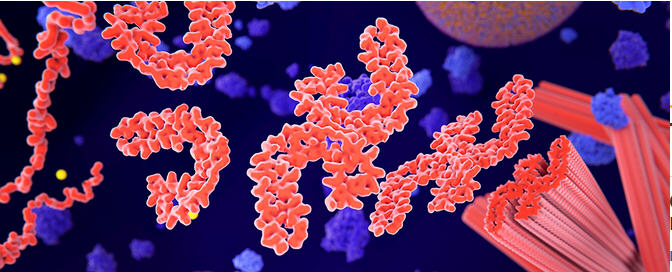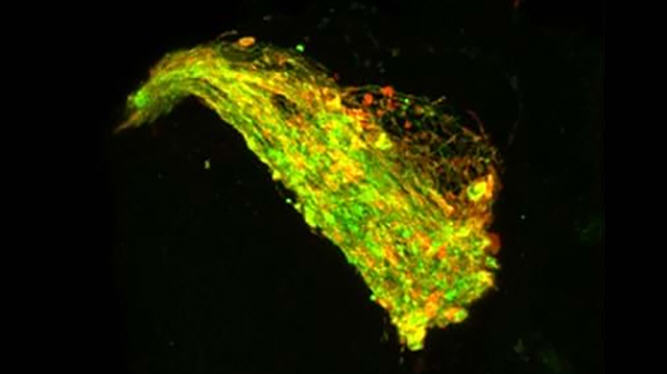博文
突破阿尔茨海默病药物靶向关键“热点”抑制有毒缠结
||
突破阿尔茨海默病药物靶向关键“热点”抑制有毒缠结
诸平
Fig. 1 Tau proteins (red-orange) interrupt normal neuron operation. (Selvanegra/iStock/Getty Images Plus)
据“科学报警”(sciencealert)网站2024年10月7日报道,突破阿尔茨海默病药物靶向关键“热点”抑制有毒缠结(Breakthrough Alzheimer's Drug Targets Key 'Hotspots' to Suppress Toxic Tangles)。
受阿尔茨海默病(Alzheimer's disease)影响的大脑的特点是具有破坏性的团块和缠结,干扰神经元,但一项新的研究描述了一种药物,可能会此问题的一半得到抑制。相关研究结果于2024年10月3日已经在《阿尔茨海默病与痴呆》(Alzheimer's & Dementia)杂志网站在线发表——Anthony Aggidis, George Devitt, Yongrui Zhang, Shreyasi Chatterjee, David Townsend, Nigel J Fullwood, Eva Ruiz Ortega, Airi Tarutani, Masato Hasegawa, Amber Cooper, Philip Williamson, Ayde Mendoza-Oliva, Marc I Diamond, Amritpal Mudher, David Allsop. A novel peptide-based tau aggregation inhibitor as a potential therapeutic for Alzheimer's disease and other tauopathies. Alzheimer's & Dementia, 2024 Oct 3. DOI: 10.1002/alz.14246. https://alz-journals.onlinelibrary.wiley.com/doi/10.1002/alz.14246
参与此项研究的有来自英国南安普顿大学(University of Southampton, Southampton, UK)、英国兰卡斯特大学(University of Lancaster, Lancaster, UK)、英国诺丁汉特伦特大学(Nottingham Trent University, Nottingham, UK)、日本东京都医学研究所(Tokyo Metropolitan Institute of Medical Science, Tokyo, Japan)以及美国德克萨斯大学西南医学中心(University of Texas Southwestern Medical Center, Dallas, Texas, USA)的研究人员。
这种药物是RI-AG03,是一种肽抑制剂(peptide inhibitor),也就是一种蛋白质阻滞剂。在对果蝇和人类细胞的测试中,它在减少神经元退化和tau蛋白缠结方面显示出积极的作用。以果蝇为例,它们的寿命延长了35%。
这项研究背后的国际研究小组表示,RI-AG03的特别之处在于,它针对tau蛋白上两个特定的“热点”,在那里容易发生结块,产生被称为原纤维(called fibrils)的长而扭曲的线。
来自英国南安普顿大学(University of Southampton, Southampton, UK)的神经科学家Amritpal Mudher说:“tau蛋白的两个区域就像拉链一样使其能够聚集。我们第一次有了一种能有效抑制这两个区域的药物。这种双重靶向机制很重要,因为它解决了刺激tau聚集的两个领域,可能为更有效地治疗阿尔茨海默氏症等神经退行性疾病铺平道路。”
大脑中的tau蛋白(tau proteins)并不都是有害的(all bad)。健康时,它们有助于维持神经元各分支的稳定性。但在一些阿尔茨海默氏症患者的大脑(some Alzheimer's brains)中,无论是作为疾病的原因还是结果,它们的原纤维都进入了超速状态(go into overdrive)。
RI-AG03药物是使用计算生物学技术生产的,专门针对tau蛋白上的两个纤维区。在这些实验中显示的有效性证明了一种成功的药物设计,即使在用于人类之前还有很多工作要做。由于RI-AG03的特殊设计方式,它被精确定位。当涉及到试图在大脑中进行药物诱导的改变(changes in the brain)时,至关重要的是,在这个最脆弱的系统中没有附带损害。
来自南安普顿大学的神经科学家安东尼·阿吉迪斯(Anthony Aggidis)说:“目前的聚集抑制剂有很多副作用,因为它们会干扰许多其他蛋白质的功能。RI-AG03是专门针对tau蛋白设计的,这意味着它不太可能与其他蛋白质产生不良反应。”
这种特殊药物的下一阶段将在老鼠身上进行测试,之后可以开始临床试验(clinical trials)。但是,尽管许多基于tau的疗法在动物模型中显示出成功,但迄今为止,许多tau的疗法未能在人类身上提供临床益处(failed to provide)。
安东尼·阿吉迪斯说:“我们的研究代表着朝着创造预防阿尔茨海默病等疾病进展的治疗方法迈出了重要的一步。通过靶向tau蛋白上的两个关键区域,这种独特的方法可以帮助解决痴呆症对社会日益增长的影响,为治疗这些毁灭性疾病提供急需的新选择。”
上述介绍,仅供参考。欲了解更多信息,敬请注意浏览原文或者相关报道。
Introduction: As aggregation underpins Tau toxicity, aggregation inhibitor peptides may have disease-modifying potential. They are therefore currently being designed and target either the 306VQIVYK311 aggregation-promoting hotspot found in all Tau isoforms or the 275VQIINK280 aggregation-promoting hotspot found in 4R isoforms. However, for any Tau aggregation inhibitor to potentially be clinically relevant for other tauopathies, it should target both hotspots to suppress aggregation of Tau isoforms, be stable, cross the blood-brain barrier, and rescue aggregation-dependent Tau phenotypes in vivo.
Methods: We developed a retro-inverso, stable D-amino peptide, RI-AG03 [Ac-rrrrrrrrGpkyk(ac)iqvGr-NH2], based on the 306VQIVYK311 hotspots which exhibit these disease-relevant attributes.
Results: Unlike other aggregation inhibitors, RI-AG03 effectively suppresses aggregation of multiple Tau species containing both hotspots in vitro and in vivo, is non-toxic, and suppresses aggregation-dependent neurodegenerative and behavioral phenotypes.
Discussion: RI-AG03 therefore meets many clinically relevant requirements for an anti-aggregation Tau therapeutic and should be explored further for its disease-modifying potential for Tauopathies.
Highlights: Our manuscript describes the development of a novel peptide inhibitor of Tau aggregation, a retro-inverso, stable D-amino peptide called RI-AG03 that displays many clinically relevant attributes. We show its efficacy in preventing Tau aggregation in both in vitro and in vivo experimental models while being non-toxic to cells. RI-AG03 also rescues a biosensor cell line that stably expresses Tau repeat domains with the P301S mutation fused to Cer/Clo and rescues aggregation-dependent phenotypes in vivo, suppressing neurodegeneration and extending lifespan. Collectively our data describe several properties and attributes of RI-AG03 that make it a promising disease-modifying candidate to explore for reducing pathogenic Tau aggregation in Tauopathies such as Alzheimer's disease. Given the real interest in reducing Tau aggregation and the potential clinical benefit of using such agents in clinical practice, RI-AG03 should be investigated further for the treatment of Tauopathies after validation in mammalian models. Tau aggregation inhibitors are the obvious first choice as Tau-based therapies as much of Tau-mediated toxicity is aggregation dependent. Indeed, there are many research efforts focusing on this therapeutic strategy with aggregation inhibitors being designed against one of the two aggregation-promoting hotspots of the Tau protein. To our knowledge, RI-AG03 is the only peptide aggregation inhibitor that inhibits aggregation of Tau by targeting both aggregation-promoting hotspot motifs simultaneously. As such, we believe that our study will have a significant impact on drug discovery efforts in this arena.
https://blog.sciencenet.cn/blog-212210-1454531.html
上一篇:2024年诺贝尔化学奖授予美英3位科学家
下一篇:革新空间通信:利用尖端等离子体技术实现424Gbit/s

